Although an important restoration and alteration of the main city aqueduct, the
Aqua Virgo, had already been made by pope Nicholas V around the 1450s, it was no
sooner than during the second half of the 16th century, when the city had already
stepped out of its darkest age, and the population had reached again a
considerable density, that the local administrators began to draft the first projects for
having new fountains set in a number of city squares, for both public utility
and - once again after a thousand years - for artistic/architectural
purposes, a choice that marked the age of Renaissance. Together with the larger fountains, the number of minor
outputs that drew water from the revived aqueducts began to grow, as well, so to serve a
greater number of spots throughout the city.
These small public
facilities were used both by the local dwellers, for drinking and for other daily
necessities (running water in houses was still a very long way to come), and by the many
thirsty horses, which in those days represented the bulk of Rome's "traffic".
In fact, another name which most small fountains used to be called with was
beveratore, old word for "drinking-trough".
They usually hung from a wall, where one or more nozzles, often embellished
with grotesque faces, animal heads and other decorations in relief,
spouted water into a small basin beneath. |

a very simple trough, with no decoration |
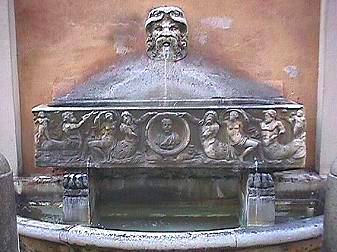
the sarcophagus in via Bocca di Leone |
The latter was frequently
rectangular in shape, resting directly on the ground or on a platform, or
on rests. Due to the wealth of ancient roman remains, which throughout the
Middle Ages had been totally disregarded, basins for these fountains were often
obtained by reusing old sarcophagi, in most cases beautifully carved, sometimes bought
from privates or churches, in whose estates they had been lying abandoned for centuries, or
had been found during maintainance works.
Among the many samples are the ones in via di Santo Stefano del Cacco, in via Bocca di Leone,
in the courtyard of San Silvestro in Capite's church, and by the Colosseum (next to the
subway station).
|
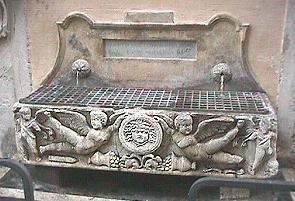
sarcophagus-fountains were set in the streets... |
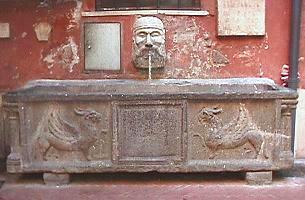
...and some were found in the precincts of churches |
Sometimes not sarcophagi, but tubs made of stone or marble,
coming from the many public baths of ancient Rome, were used for the new fountains.
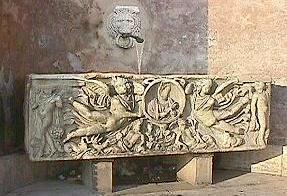
the sarcophagus-trough by the Colosseum |

tub-shaped trough in Sant'Angelo Castle's grounds |
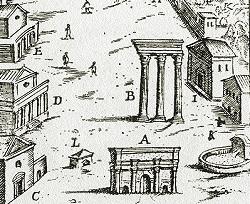
the Roman Forum in the early 17th century:
note the round trough in the lower right corner,
used by cattle, whose market was once held here |
Also other kinds of remains could have been suitable; for instance, the large round basin
found in the late 1500s beneath Marforio's statue, as described
in the previous part I, was turned into a trough, but
an old urn, or even the hollow shaft of a broken column, placed under a water
output, would have worked well for this purpose.
Besides the drinking-troughs, a number of fountains were more specifically designed
for the people. Usually these ones had a smaller basin, at a higher level than a trough,
and their decoration could considerably vary in richness.
However, the great importance that
all of them had for the neighborhood's life can be told by the fact that in some cases the street
where they stood was named after the fountain, regardless of its size and artistic value. |
A typical case is that of
Fontanella Borghese, now a plain nozzle (the original decoration
went lost) with a tiny basin, located at the back of Palazzo Borghese. The latter is one of
Rome's hugest, most important noble palaces, in whose courtyard stands a
beautiful ornate fountain, over twenty times the size of this one.
Nevertheless, this insignificant and rather miserable looking output was given the name of the
Borghese family.
However, the fountain was originally built at the expenses of another family, the Della Genga,
around year 1600, therefore it might have been initially called Fontanella Della Genga.
But the looming presence of Palazzo Borghese, the most important landmark of
the neighborhood, probably caused this output to be more easily identifiable with the new name.
And the street where it stands and a nearby square were both named Fontanella Borghese,
after the small fountain.
|
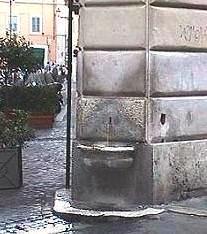
the tiny Fontanella Borghese |
Still small, but certainly prettier, are the two
niche-shaped fountains hanging on the wall of Palazzo della Rovere, along the southern
side of via della Conciliazione, in Borgo district, next to the Vatican. They are almost twins, but one them
comes from a building taken down during the works for the opening of this modern avenue.
 |
Their decoration is a dragon, and one of them also features an eagle,
both belonging to the crest of the Borghese family, in honour of pope Paul V (1605-21),
i.e. Camillo Borghese.
The water they pour is drawn from the Acqua Paola, the reactivated aqueduct once called
Aqua Traiana, whose restoration and reopening had been sponsored by the same pope in the
early years of the 17th century. |
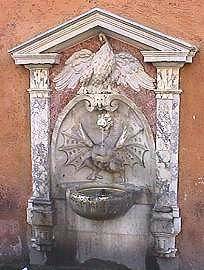 |
One of the two bears the three letters S P A, acronym for
Salus Per Aqua ("health by means of water" in Latin), a mark which used
to be placed on sources of water believed to be good for one's health.

the fountain by the pawn-shop |
Family crests are a common feature on Rome's fountains,
and the Borghese dragon and eagle are among the ones most frequently found. In the same Borgo
district once stood another fountain known as Mascherone di Borgo ("Borgo's grotesque
face") with a Borghese eagle on it, but when the local houses were roughly pulled down
in the 1930s also the fountain went lost. |
 |
However, a very similar one still decorates the front of Palazzo del Monte di Pietà, in
Regola district, the building that houses the public pawn-shop (an establishment founded in
1539). As the lost fountain in Borgo did, also this one pours water from a grotesque face,
above which the Borghese eagle perches with open wings. Lacking an official name, it is simply
referred to as "the fountain of Palazzo del Monte di Pietà". It dates back to the 1600s.
|
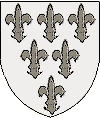 |
Not far from the previous one, the Fontana
del Mascherone ("grotesque face fountain") features the insignia of a different family.
Located in the charming Renaissance atmosphere of via Giulia (see The 22 Rioni,
Ponte and Regola), it draws water from
the Acqua Paola aqueduct, which had been opened a few years earlier. |
The water pours from the large face and fills the smaller basin, trickling down into
the larger one below. The face and the trough are ancient roman remains. The metal
fleur-de-lys above the fountain, instead, reminds us of its owners, the Farnese,
the important family in whose crest are six of these flowers. This facility was built at
their expenses, right behind the family's great palace, in front of which stand two more
full-sized fountains (described in part III).
Another crest is featured on the plain marble trough in piazza del Nazzareno, which bears
a buffalo's head for the Del Bufalo family; it was heavily restored in the late 1950s.
Over the doorway of their palace, facing the fountain, is a similar head.
|
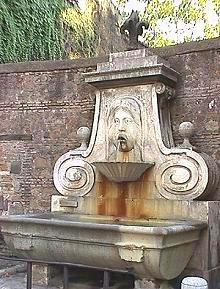
the grotesque face of via Giulia |
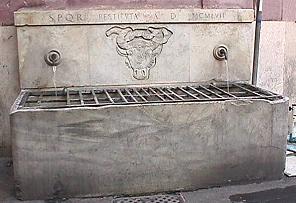
the trough of the Del Bufalo family
Besides the owner's emblems, also plaques inscribed in Latin were sometimes
added to the small fountain's decoration; in many cases they simply praise
their owner, but in doing so they sometimes provide some additional information.
|

the trough by Porta Cavalleggeri
|
An example is the trough in via di Porta Cavalleggeri,
with a lion's head for the nozzle and a sarcophagus decorated with a traditional
wavy-shaped motif: its upper inscription reads that pope Pius IV had the output set
here in 1565 "for the benefit of the mounted soldiers", the Cavalleggeri corps
whose barracks stood nearby, after which the place was named.
After some time the fountain must have stopped working, because the lower plaque remembers another
pope, Clement XI, for having reactivated it in 1713.
A large plaque also hangs above the small fountain located by the church of San Salvatore in
Lauro. Shaped as a small grotto, i.e. a niche with very rough walls, the water gushes from
a rather low output into a tiny basin; in its best days, the output may have been shaped as a lion's head,
now barely recognizable.